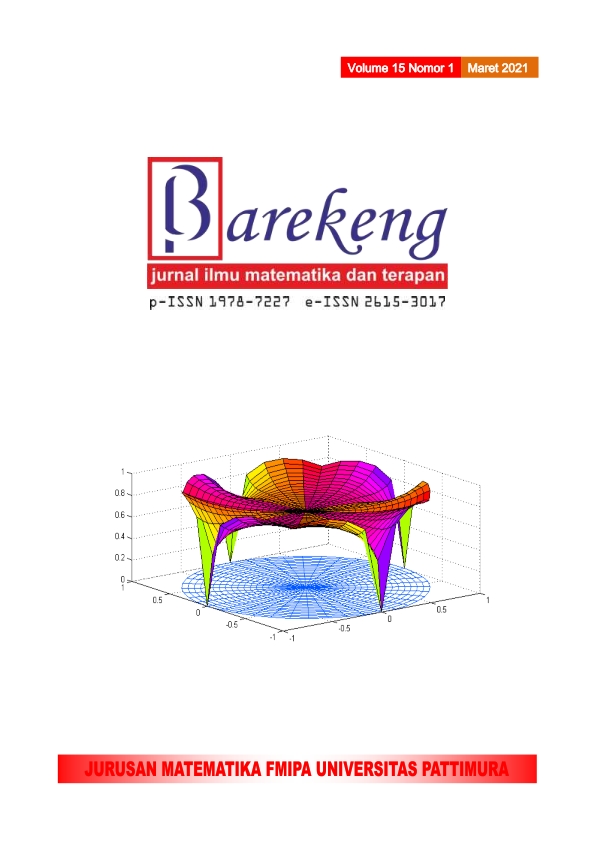PEMODELAN DINAMIKA VIRUS RUBELLA DENGAN RISIKO SINDROM RUBELLA BAWAAN
Abstract
Rubella is a common cause of childhood rash and fever. It is typically a mild infection but it can be serious condition in pregnant women, as it may cause Congenital Rubella Syndrome (CRS) in the fetus. The study aimed to model and analyze it in order to get picture about the dynamics of the rubella virus transmission. The paper discussed two models of rubella transmission involving child-bearing age women and newly born infants of infected mothers. The models are SEIR-IR without seasonality and SEIR-IR with seasonality. The results from the first model showed that a pitchfork bifurcation occurred in the dynamics of the solution of the system with constant infection rate and the increase of the infection rate value do not make impact to the incidence of rubella among infants. The second model involving seasonality gave interesting dynamics where big seasonality may lead to a more complex dynamics of the solution.
Downloads
References
F. T. Cutts, S. E. Robertson, J.-L. Diaz-Ortega, and R. Samuel, “Control of rubella and congenital rubella syndrome (CRS) in developing countries, part 1: burden of disease from CRS,†Bulletin of World Health Organization, vol. 75, no. 1, pp. 55-68, 1997.
E. S. Herini, Gunadi, A. Triono, A. W. E. Mulyadi, N. Mardin, Rusipah, Y. Soenarto, and S. E. Reef, “Hospital-based surveillance of congenital rubella syndrome in Indonesia,†Eur J Pediatr., vol. 176, pp. 387-393, 2017.
P. E. M. Fine and J. A. Clarkson, “Measles in England and Wales—I: An Analysis of Factors Underlying Seasonal Patterns,†International Journal of Epidemiology, vol. 11, no. 1, pp. 1-14, 1982.
L. F. Olsen, G. L. Truty, and W. M. Schaffer, “Oscillations and Chaos in Epidemics: A Nonlinear Dynamics Study of Six Childhood Diseases in Copenhagen, Denmark,†Theoretical Population Biology, vol. 33, pp. 344-370, 1988.
Z. Gao, J. G. Wood, M. A. Burgess, R. I. Menzies, P. B. McIntyre, and C. R. MacIntyre, “Models of strategies for control of rubella and congenital rubella syndrome – A 40 year experience from Australia,†Vaccine, 31, pp. 691-697, 2013.
H. Lee, T. Kayano, and H. Nishiura, “Predicting congenital rubella syndrome in Japan 2018-2019,†Int. J. Infectious Diseases, vol. 82, pp. 1-5, 2019.
C. J. E. Metcalf, O. N. Bjornstad, M. J. Ferrari, P. Klepac, N. Bharti, H. Lopez-Gatell, and B. T. Grenfell, “The epidemiology of rubella in Mexico: seasonality, stochasticity and regional variation,†Epidemiol. Infect. vol. 139, 1029-1038, 2011.
Y. Wu, J. Wood, G. Khandaker, C. Waddington, and T. Snelling,†Informing rubella vaccination strategies in East Java, Indonesia through transmission modelling,†Vaccine, vol. 34, no. 46, pp. 5636-5642, 2016.
A. R. McLean and R. M. Anderson, “Measles in developing countries Part I. Epidemiological parameters and patterns,†Epidem. Inf. vol. 100, 111-133, 1988.
D. Walker, H. Carter, and I. G. Jones, “Measles, mumps, and rubella: the need for a change in immunisation policy,†British Med. J. vol. 292, pp. 1501-1502, 1986.
M. J. Keeling and P. Rohani, Modeling Infectious Diseases in Humans and Animals, Princestone, NJ: Princestone University Press, 2008.
M. Keeling, P. Rohani, and B. T. Grenfell, “Seasonality forced disease dynamics explored as switching between attractors,†Physica D, vol. 148, pp. 317-335, 2001.
P. Pongsumpun and I. M. Tang, “Effect of the Seasonal Variation in the Extrinsic Incubation Period on the Long Term Behavior of the Dengue Hemorraghic Fever Epidemic,†Inter. J. Math. and Comp. vol. 1, no. 10, 483-489, 2007.
J. Ma and Z. Ma, “Epidemic threshold conditions for seasonality forced SEIR models,†Mathematical Biosciences and Engineering, vol. 3, no. 1, pp. 161-172, 2006.
J. Hale and H. Kocak, Dynamics and Bifurcations, Springer-Verlag New York, Inc., 1996.
R. M. May and R. M. Anderson, “Population biology of infectious diseases: Part I,†Nature, vol. 280, pp. 361-367, 1979.
C. Chicone, Ordinary Differential Equations with Applications, Springer-Verlag New York, Inc., 1999.
S. Gao, Y. Liu, J. J. Nieto, and H. Andrade, Seasonality and Mixed Vaccination Strategy in Epidemic Model with Vertical Transmission, Math. Computers Simul. vol. 8, 1855 – 1868, 2011.
N. Lambert, et. al., Rubella, The Lancet, vol. 385, No, 9984, 2297–2307, 2015.
C. J. E. Metcalf et. al. The epidemiology of rubella in Mexico: seasonality, stochasticity and regional variation, Epidemiol. Infect. vol. 139, 1029 – 1038, 2011.
Abadi, R. Artiono, B. P. Prawoto, The effects of vaccination to the dynamics of rubella virus with seasonality, Commun. Math. Biol. Neurosci. vol. 2020, 2020.
Authors who publish with this Journal agree to the following terms:
- Author retain copyright and grant the journal right of first publication with the work simultaneously licensed under a creative commons attribution license that allow others to share the work within an acknowledgement of the work’s authorship and initial publication of this journal.
- Authors are able to enter into separate, additional contractual arrangement for the non-exclusive distribution of the journal’s published version of the work (e.g. acknowledgement of its initial publication in this journal).
- Authors are permitted and encouraged to post their work online (e.g. in institutional repositories or on their websites) prior to and during the submission process, as it can lead to productive exchanges, as well as earlier and greater citation of published works.






1.gif)



